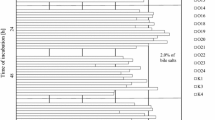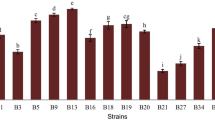Abstract
Twenty-four acid- and bile-tolerant lactobacilli isolates from dairy products were identified and further in vitro characterized for the presence of functional traits potentially useful for probiotic applications, which included desirable and undesirable traits, such as biofilm formation, ability to inhibit intestinal pathogens, antibiotic susceptibility, and enzyme activity. The majority of examined strains were susceptible to certain antimicrobial agents (streptomycin, gentamicin, clindamycin, erythromycin, tetracycline, quinupristin–dalfopristin), except for three strains of Lactobacillus rhamnosus with minimal inhibitory concentration levels for streptomycin higher than the microbiological breakpoints (≥32 μg/mL), which are considered as resistant. Undesirable traits such as α-chymotrypsin or N-acetyl-β-glucosaminidase activities were not detected, but low β-glucuronidase, and moderate and high β-glucosidase activities were recorded in nine strains, which were eliminated from further examination together with three isolates showing unsuitable antibiotic resistance. Of the remaining 12 isolates, 4 (Lactobacillus fermentum 202, Lactobacillus gallinarum 7001, L. rhamnosus 183, and Lactobacillus plantarum L2-1) manifested an outstanding potential to inhibit selected intestinal pathogens in an agar spot test, including Escherichia coli and Salmonella spp., and simultaneously demonstrated strong biofilm-forming capacity. In conclusion, the results of our in vitro experiments showed that the above four strains had a potential probiotic value and met the criteria to be identified as a possible probiotic microorganism, with the necessity of verification through well-designed in vivo experimental, clinical, and technological studies before the strains can be used as probiotics or as starter probiotic cultures.
Similar content being viewed by others
References
Ambadoyiannis G, Hatzikamari M, Litopoulou-Tzanetaki E, Tzanetakis N (2005) Probiotic and technological properties of enterococci isolates from infants and cheese. Food Biotechnol 18:307–325
Arora G, Lee BH, Lamoureux M (1990) Characteristics of enzyme profiles of Lactobacillus casei species by a rapid API–ZYM system. J Dairy Sci 73:264–273
Aslim B, Yuksekdag ZN, Sarikaya E, Beyatli Y (2005) Determination of the bacteriocin-like substances produced by some lactic acid bacteria isolated from Turkish dairy products. LWT- Food Sci Technol 38:691–694
Bernet-Camard MF, Lievin V, Brassart D, Neeser JR, Servin AL, Hudault S (1997) The human Lactobacillus acidophilus strain LA1 secretes a non-bacteriocin antibacterial substance(s) active in vitro and in vivo. Appl Environ Microbiol 63:2747–2753
Bessède E, Angla-gre M, Delagarde Y, Sep Hieng S, Ménard A, Mégraud F (2011) Matrix-assisted laser-desorption/ionization biotyper: experience in the routine of a University hospital. Clin Microbiol Infect 17:533–538
Dunne C, O’Mahony L, Murphy L, Thornton G, Morrissey D, O’Halloran S, Feeney M, Flynn S, Fitzgerald G, Daly C, Kiely B, O’Sullivan GC, Shanahan F, Collins JK (2001) In vitro selection criteria for probiotic bacteria of human origin: correlation with in vivo findings. Am J Clin Nutr 73:386S–392S
FAO/WHO (2002) Guidelines for the evaluation of probiotics in food. Report of a joint FAO/WHO working group on drafting guidelines for the evaluation of probiotics in food. London, Ontario (April 30 and May 1, 2002)
Heavey PM, Rowland IR (2004) Microbial-gut interactions in health and disease. Gastrointestinal cancer. Best Pract Res Clin Gastroenterol 18:323–336
Hussain M, Khan NT, Wajid A, Rasool SA (2008) Technological characterization of indigenous enterococcal population for probiotic potential. Pak J Bot 40:867–875
Jacobsen CN, Rosenfeldt Nielsen V, Hayford AE, Møller PL, Michaelsen KF, Pærregaard A, Sandstrom B, Tvede M, Jakobsen M (1999) Screening of probiotics activities of forty-seven strains of Lactobacillus spp. by in vitro techniques and evaluation of the colonization ability of five selected strains in humans. Appl Environ Microbiol 65:4949–4956
Koninkx JFJG, Malago JJ (2006) The protective potency of probiotic bacteria and their microbial products against enteric infections—review. Folia Microbiol 53:189–194
Kushiro A, Chervaux CH, Cools-Portier S, Perony A, Legrain-Raspaud S, Obis D, Onoue M, Moer A (2009) Antimicrobial susceptibility testing of lactic acid bacteria and bifidobacteria by broth microdilution method and E-test. Int J Food Microbiol 132:54–58
Panel on Additives and Products or Substances used in Animal Feed (FEEDAP) (2008) Technical guidance on the update of the criteria used in the assessment of bacterial resistance to antibiotics of human or veterinary importance. EFSA J 732:1–15
Probert HM, Gibson GR (2002) Bacterial biofilms in the human gastrointestinal tract. Curr Issues Intest Microbiol 3:23–27
Salyers AA, Gupta A, Wang Y (2004) Human intestinal bacteria as reservoirs for antibiotics resistance genes. Trends Microbiol 12:412–416
Toledo-Arana A, Valle J, Solano C, Arrizubieta MJ, Cucarella C, Lamata M, Amorena B, Leiva J, Penadés JR, Lasa I (2001) The enterococcal surface protein, Esp, is involved in Enterocccus faecalis biofilm formation. Appl Environ Microbiol 67:4538–4545
Acknowledgments
The work was financially supported by the ERDF project no. 26220220152. We would like to thank Assoc. Prof. Greiffová from the Institute of Biotechnology and Food Science (Faculty of Chemical and Food Technology, Slovak University of Technology, Bratislava, Slovakia) for kindly providing the lactobacilli strains.
Author information
Authors and Affiliations
Corresponding author
Rights and permissions
About this article
Cite this article
Bujňáková, D., Kmeť, V. Functional properties of Lactobacillus strains isolated from dairy products. Folia Microbiol 57, 263–267 (2012). https://doi.org/10.1007/s12223-012-0121-x
Received:
Accepted:
Published:
Issue Date:
DOI: https://doi.org/10.1007/s12223-012-0121-x




